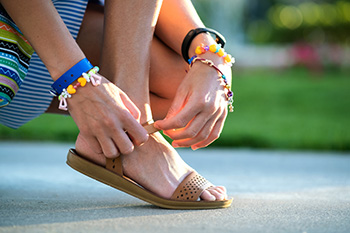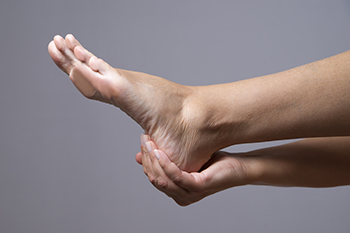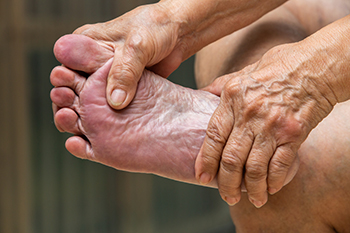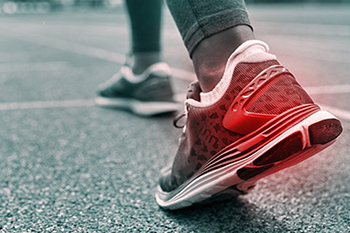Items filtered by date: May 2023
Are Sandals Harmful to the Feet?

Sandals have become common footwear year round, mainly because they are lightweight, easy to put on and take off, comfortable, and attractive. But are sandals good for your feet? Experts are keen to point out that sandals and flip flops provide little arch support. They also lack ample cushioning, as the soles may be thin and made of hard materials. Further, sandals provide minimal side-to-side support and do very little to protect the feet from trauma. Other experts believe that if you are not suffering any ill effects from wearing sandals or flip flops, then go right ahead. They also point out that it may be beneficial to find sandals with a molded arch and straps to keep the foot more stable. Sandals with high wedges are thought to put the wearer at risk for twisted ankles or falls. If you are feeling foot pain of any type after wearing sandals, it is suggested that you make an appointment with a chiropodist for an evaluation and possible treatment options.
Caring for your feet is not just something done at the chiropodist’s office. Good foot care starts at home. If you would like to learn more about daily foot care practices, please consult with one of the chiropodists from Complete Family Footcare & Therapy. Our clinicians can help you maintain the health of your lower limbs and your mobility.
There are many things that you can do at home to help care for your feet, including:
-
Wearing shoes and socks that fit properly
-
Washing the feet daily with soap and water
-
Drying the feet thoroughly
-
Applying moisturizer to the soles and heels of the feet
-
Taking a walk and exercising the feet regularly
-
Doing foot stretches and strengthening exercises
A chiropodist can help figure out a manageable foot care routine for you to keep your feet healthy. If you have any questions, please feel free to contact our offices located in . We offer the newest diagnostic and treatment technologies for all your foot care needs.
Pain in the Arch of the Foot

Pain felt in the arch of the foot is often caused by plantar fasciitis, which is an inflammation of the band of tissue that runs along the bottom of the foot, and connects the toes to the heels. Other causes of arch pain include posterior tibial tendon dysfunction, which is also known as adult-acquired flat feet or PTTD. Cavus foot, which is defined as having excessively high arches can cause pain. Overpronation, which can happen when the outside of the heel touches the ground first as the foot rolls inward while walking, may also result in arch pain. Additional causes of arch pain can include obesity, aging, overuse, and physical stress. Any injury to the muscles, bones, ligaments, or tendons in the feet can cause pain in the arch of the foot. Arch pain, if ignored, can lead to more serious foot problems, as well as ankle, knee, and back pain. If pain in the arch of your foot doesn’t improve or continues to get worse, it is suggested that you make an appointment with a chiropodist who can determine what the proper course of treatment is for you.
Foot pain is a common problem treated by chiropodists. If you have foot pain, please consult with one of the chiropodists from Complete Family Footcare & Therapy. Our clinicians can help you maintain the health of your lower limbs and your mobility.
When you are experiencing foot pain, it’s important to note the type of pain and its location, as this can help determine a diagnosis.
Pain in the top of the foot may be caused by:
-
Stress fractures
-
Sinus tarsi syndrome
-
Extensor tendonitis
-
Tibialis anterior tendonitis
-
Gout
-
Athlete’s foot
-
Ganglion cysts
Pain in the bottom of the foot may be caused by:
-
Plantar fasciitis
-
Foot cramps
-
Tarsal tunnel syndrome
-
Plantar fibromatosis
-
Posterior tibial tendonitis
-
Stress fractures
-
Flat feet
Pain on the side of the foot may be caused by:
-
Ankle sprain
-
Cuboid syndrome
-
Peroneal tendonitis
-
Stress fractures
-
Bunions
-
Corns or calluses
-
Posterior tibial tendonitis
Heel pain may be caused by:
-
Plantar fasciitis
-
Achilles tendonitis
-
Bone spurs
-
Heel fractures
-
Retrocalcaneal bursitis
-
Sever’s disease
Pain in the toes may be caused by:
-
Gout
-
Hammertoe
-
Turf toe
-
Bunions
-
Ingrown toenails
-
Blisters
-
Arthritis
These and many more conditions can be treated by a chiropodist. If you have any questions, please feel free to contact our offices located in . We offer the newest diagnostic and treatment technologies for all your foot care needs.
Importance of Foot Care in Seniors

As a person ages, their feet age too, and this causes the feet of older adults to be more susceptible to painful conditions. One of the first differences in the feet is the thinning of the fat pads under the heels. As these natural cushions diminish, simply walking and standing can induce pain. In addition, as the skin begins to lose elasticity and dry out, older adults are more likely to develop cracked heels. If not cared for, cracked heels can become fissures that open the skin to bacterial and fungal infections. As women grow older, osteoporosis can set in, causing the bones to become more brittle. This can produce stress fractures from repetitive exercise, or even just from everyday activities. Osteoarthritis, which is the breakdown of cartilage between the bones of the foot’s many joints, is frequently diagnosed after the age of 65. This condition also increases the pain in the feet. For help with any of these foot issues, it is suggested that you make an appointment with a chiropodist for a thorough exam and treatment options.
Foot problems can become increasingly common as we age, making everyday foot care especially important. To learn more about maintaining proper foot health, please consult with one of the chiropodists from Complete Family Footcare & Therapy. Our clinicians will assess your condition and provide you with quality foot and ankle treatment.
Common Foot Problems
Certain foot problems may be more likely to affect older adults.
Some examples of foot conditions that can be common in older adults include:
-
Dry, cracked skin
-
Calluses and corns
-
Blisters
-
Ingrown toenails
-
Deformities such as bunions or hammertoes
-
Fungal infections
-
Plantar warts
Systemic conditions, such as diabetes or arthritis, are also more likely to affect older people and manifest symptoms in the feet and ankles.
Daily Foot Care Tips
Having a daily foot care routine can help detect problems early on and prevent future issues.
Things that you can do at home to care for your feet include:
-
Washing the feet daily with warm water, drying them thoroughly, and then applying a moisturizer
-
Trimming the toenails straight across and not too short to prevent ingrown toenails
-
Performing daily foot exercises to improve foot strength and mobility
-
Wearing shoes when walking to avoid injury
-
Inspecting the feet daily for any cuts, scrapes, sores, or other abnormalities and seeking prompt treatment if any problems are discovered
If you have any questions, please feel free to contact our offices located in . We offer the newest diagnostic and treatment technologies for all your foot care needs.
Non-slip Shoes Help Prevent Falls in Hospitals

Many people are injured and hospitalized each year after taking a fall. But a large number of falls actually occur in hospitals, too. For that reason, hospital workers can benefit from wearing slip-resistant footwear to prevent themselves from falling. The nature of hospital care is often urgent, and when people hurry they are more at risk for falls. Floors in hospitals are highly polished and can be slippery from recent applications of disinfectants and other liquid spills. Non-slip shoes for hospital workers should have soles made of rubber, experts say, because it is more durable and provides the extra grip needed in cases of wet floors. The sole should not be so thick that it becomes inflexible, however. Make sure the shoes fit well and leave room for the toes to move in freely. Shoes also should provide ample cushioning and arch support for long periods hospital workers spend on their feet. For further help in choosing a non-slip shoe that is best for you, it is suggested that you consult a chiropodist who can meet your foot care needs.
Falls are a major cause of injury among the elderly. To learn more about preventing falls or to get treatment following a foot or ankle injury caused by a fall, please consult with one of the chiropodists from Complete Family Footcare & Therapy. Our clinicians will assess your condition and provide you with quality foot and ankle treatment.
Falling is one of the leading causes of injury among the elderly. It is said that about 50% of falls that result in hospitalization occur in the home. Fortunately, there are steps that you can implement to reduce your risk of falling in the home.
Tips to Prevent Falls at Home:
-
In the bathroom - Place non-slip mats in the shower or tub, install grab bars near the toilet and bath, and wipe up any moisture or spills as soon as possible.
-
In the living rooms and bedroom - Remove loose wires, cords, or other objects that may be an obstacle to moving around safely. Make sure that you have good lighting throughout the home so that you can always see where you are going. Get rid of any rugs or mats that are not firmly anchored or that may cause you to trip. When walking around the home, move slowly.
-
In the kitchen - Store food and supplies in easily accessible areas, store heavy items in lower cupboards, and wipe up any spills immediately to prevent slipping.
-
On the stairs - Make sure that the stairs are well-lit and have secure handrails. Walk slowly when ascending or descending the stairs.
-
Outside - Keep walkways well-lit and clear of snow, ice, leaves, and man-made tripping hazards.
Maintaining your overall health, including the health of your feet, can also help to prevent falls. Eat a healthy diet, exercise regularly, and wear well-fitted, comfortable, and supportive shoes. If you have a mobility device, such as a cane, use it while walking.
If you have any questions, please feel free to contact our offices located in . We offer the newest diagnostic and treatment technologies for all your foot care needs.
Are You Suffering From Ingrown Toenails?
Is It OK to Wear Running Shoes for Walking?

Running shoes have different characteristics than walking shoes. Runners and fitness walkers should not run in walking shoes because walking shoes are too stiff and do not flex. However, walkers and fitness runners can find running shoes that meet their needs better than some walking shoes. The bottom line is knowing the qualities to look for in shoes to help pick the best shoes for their needs. Running shoes have different functions, and designers keep them updated with the newest materials and technology to meet different running styles and needs. Specifically, running shoes vary in the amount of cushioning they have, levels of a heel-to-toe drop to serve the needs of different ways runners strike the ground and stability. Walking shoes have lagged in technology and are often designed more for comfort than performance. It reasons that running shoes are more advanced and can fit many running or active walking styles. If you would like more information on which type of shoe is best for you, it is suggested that you consult with a chiropodist who can guide you in this process.
Finding the right shoes can sometimes be a major hassle, especially if you intend to work out in them. There are shoes on the market designed specifically for running and walking, but it can be difficult to differentiate between the two and find the right shoes for you. If you’re having trouble finding the right shoes, please consult with one of the chiropodists from Complete Family Footcare & Therapy. Our clinicians can help you maintain the health of your lower limbs and your mobility.
What are the differences between running and walking shoes?
These two types of shoes vary along several parameters.
-
Cushioning: Runners need more cushioning in the heel and forefoot areas of the shoe, while walkers can get away with less cushioning.
-
Heel height: Runners need a higher heel to provide them with stability, but the ideal height of the heel for runners varies depending on their running gait. Walkers generally don’t need a built-up heel.
-
Heel flare: Flared heels can help provide extra stability for runners with certain gaits, while walkers may benefit from a flared heel to control the motion of their foot.
-
Flexibility: Both runners and walkers need shoes that are flexible.
For more information about the differences between walking and running shoes, and to figure out which shoes may be right for you, please consult with a chiropodist. Feel free to contact our offices located in . We offer the newest diagnostic and treatment technologies for all your foot care needs.

